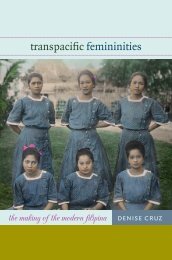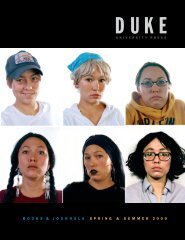Spring 2013 Catalog - Duke University Press
Spring 2013 Catalog - Duke University Press
Spring 2013 Catalog - Duke University Press
You also want an ePaper? Increase the reach of your titles
YUMPU automatically turns print PDFs into web optimized ePapers that Google loves.
Japanoise<br />
Music at the Edge of Circulation<br />
david novak<br />
“Edgy, compelling, and sharply insightful, this is the definitive book on<br />
‘Japanoise.’ Through his personal involvement in Noise scenes across two<br />
continents and over two decades, David Novak takes readers into the<br />
experience of Noise: its production and performance through apparati of<br />
wires, pedals, amplifiers, and tape loops, its intensity on the stage and<br />
in one’s ears and body.”—ANNE ALLISON, author of Millennial Monsters:<br />
Japanese Toys and the Global Imagination<br />
Noise, an underground music genre<br />
made through an amalgam of<br />
feedback, distortion, and electronic<br />
effects, first emerged in the 1980s,<br />
circulating on cassette tapes traded<br />
between fans in Japan, Europe and<br />
North America. With its cultivated<br />
obscurity, ear-shattering sound,<br />
Haino Keiji performing in New York City.<br />
Photo by the author.<br />
and over-the-top performances,<br />
Noise has captured the imagination of a small but passionate<br />
transnational audience.<br />
For its scattered listeners, Noise always seems to be new, and to<br />
come from somewhere else: in North America, it was “Japanoise.”<br />
But does Noise really belong to Japan? Is it even music at all?<br />
And why has Noise become such a compelling metaphor for the<br />
complexities of globalization and participatory media at the turn<br />
of the millennium?<br />
In Japanoise, David Novak draws on more than a decade of<br />
research in Japan and the United States to trace the “cultural<br />
feedback” that generates and sustains Noise. He provides a<br />
rich ethnographic account of live performances, the circulation<br />
of recordings, and the lives and creative practices of musicians<br />
and listeners. He explores the technologies of Noise, and the<br />
productive distortions of its networks. Capturing the textures<br />
of feedback—its sonic and cultural layers and vibrations—Novak<br />
describes musical circulation through sound and listening,<br />
recording and performance, international exchange, and social<br />
interpretations of media.<br />
David Novak is Assistant Professor of Music at the <strong>University</strong> of<br />
California, Santa Barbara.<br />
SIGN, STORAGE, TRANSMISSION<br />
A Series Edited by Jonathan Sterne and Lisa Gitelman<br />
MUSIC/ANTHROPOLOGY/JAPAN<br />
June 312 pages, 51 illustrations<br />
paper, 978–0–8223–5392–8, $24.95/£16.99<br />
cloth, 978–0–8223–5379–9, $89.95/£67.00<br />
general interest<br />
Little Manila Is in the Heart<br />
The Making of the Filipina/o American<br />
Community in Stockton, California<br />
dawn bohulano mabalon<br />
“Little Manila Is in the Heart is a triumph of Filipina/o American history and<br />
American studies. There is no other scholarly analysis of the dynamic and<br />
vibrant Filipina/o American experience central to the development of Stockton’s<br />
urban life and the larger San Joaquin Delta, a key area of California’s agribusiness.<br />
Moreover, Dawn Bohulano Mabalon is a masterful storyteller. She draws<br />
on oral histories to illuminate the pain and joy of building, sustaining, losing,<br />
and attempting to preserve Little Manila in Stockton, weaving in with great<br />
finesse family history, archival research, and her own activism on behalf of<br />
Little Manila’s preservation.”—CATHERINE CENIZA CHOY, author of Empire<br />
of Care: Nursing and Migration in Filipino American History<br />
In the early twentieth century—not<br />
long after 1898, when the United States<br />
claimed the Philippines as an American<br />
colony—Filipinas/os became a vital<br />
part of the agricultural economy of<br />
California’s fertile San Joaquin Delta.<br />
In downtown Stockton, they created<br />
Little Manila, a vibrant community<br />
of hotels, pool halls, dance halls,<br />
restaurants, grocery stores, churches,<br />
union halls, and barbershops. Little<br />
Manila was home to the largest community<br />
of Filipinas/os outside of the Philippines until the neighborhood<br />
was decimated by urban redevelopment in the 1960s. Narrating a history<br />
spanning much of the twentieth century, Dawn Bohulano Mabalon<br />
traces the growth of Stockton’s Filipina/o American community, the<br />
birth and eventual destruction of Little Manila, and recent efforts to<br />
remember and preserve it.<br />
Mabalon draws on oral histories, newspapers, photographs, personal<br />
archives, and her own family’s history in Stockton. She reveals how<br />
Filipina/o immigrants created a community and ethnic culture shaped<br />
by their identities as colonial subjects of the United States, their racialization<br />
in Stockton as brown people, and their collective experiences<br />
in the fields and in the Little Manila neighborhood. In the process,<br />
Mabalon places Filipinas/os at the center of the development of<br />
California agriculture and the urban West.<br />
Dawn Bohulano Mabalon is Associate Professor of History at San<br />
Francisco State <strong>University</strong>.<br />
HISTORY/ASIAN AMERICAN STUDIES<br />
June 464 pages, 58 illustrations<br />
paper, 978–0–8223–5339–3, $28.95/£18.99<br />
cloth, 978–0–8223–5325–6, $99.95/£75.00<br />
11












